The new, double-wide bike lane on SE Madison Ave that I reported about last week is now fully complete.
The new markings include side-by-side bike lane symbols to denote the passing lane and skip-striping both where the lane widens (and then narrows) and to separate the slow and fast lanes.
It was great to watch morning commuters fall right in to place; slower riders on the right, speedsters on the left!
When I stopped by to shoot these photos this morning, PDOT traffic engineer Scott Batson was there doing the same. I asked if the city has plans to do any more of these. He said at this point they don’t, but given how well these work and how popular they are I’m sure we’ll see more of them in the future.



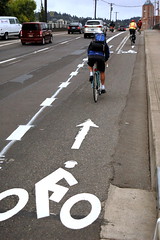
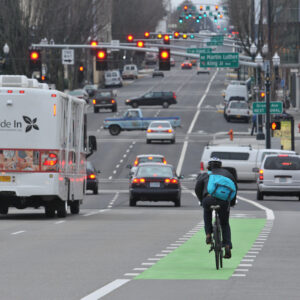
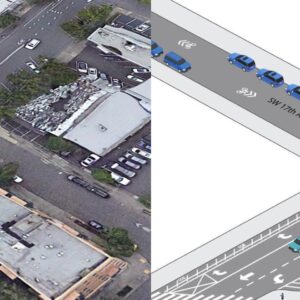
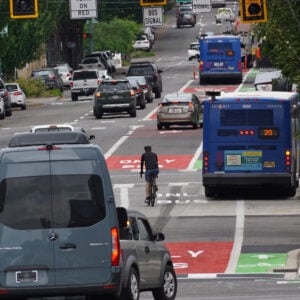
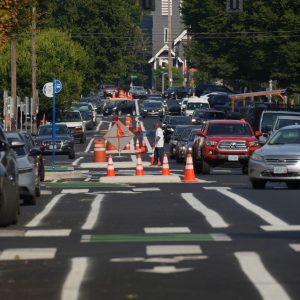
Thanks for reading.
BikePortland has served this community with independent community journalism since 2005. We rely on subscriptions from readers like you to survive. Your financial support is vital in keeping this valuable resource alive and well.
Please subscribe today to strengthen and expand our work.
+1 for double lane
The wide, short dashed lines at the very beginning of the grade (before the split) confuse me a bit. Don\’t those normally mean, lane ends, must exit or something to that effect? Otherwise, the new configuration is working great, I agree….
Jeff:
Hatched lines generally mean they can be crossed while solid lines generally mean they can not be crossed.
So, the hatched lines you are addressing are there to give guidance to busses as they transition from the bus stop to the first travel lane across the intersection.
At the same time, the hatching allows cyclists to legally cross the line to enter the double lanes that receive them.
If the line were solid, the legal maneuver for cyclists would be to enter where the gap between the stripe and the curb are and then move over. So, the solid line doesn\’t really work because it would create a bottle neck.
Thanks.
Greg Raisman
Community and School Traffic Safety Partnership
Portland Office of Transportation
(503) 823-1052
That\’s kinda cute. Is it my imagination or is the cyclist stencil in the \”slow\” lane sitting more upright than the fast cyclist stencil?
I\’m all for the increased width, but I\’m not too excited about the paint. Do we really need a dashed line implying that there are only two lanes? Seems to me, the skip stripe is yet another example of cluttery street signage that encourages folks to make unnecessary and potentially dangerous assumptions.
Whine whine whine. I know.
Is it my imagination or does the stencil on the right have a ulock in its back pocket?
Well played, coop…
Excellent work on this one Jeff, but who really has the right of way crossing MLK…TriMet or bikes? I\’ve been squeezed back at half a bus length, been told to always stay behind the bus by a driver from his window…eventhough he was 15 ft. from the stop line, and have been politely waved on by a bus to pass. Buses understandably need to make their times, but bull dogging bikes to merge onto the bridge is too dangerous.
That\’s a hairy intersection unless you are a car, intending to travel straight. The widening skip stripe seems odd to me, but it appears the best that can be done with the sitation as it is there. The widening is a bit worrisome as it presents a bigger \”xone\” for cars and bikes to enter the same space if (and only if) a driver is inattentive enough to continue arrow straight or veer right rather than sidle to the left.
In short, it is a bit odd but I think it\’ll do the job. And it shoudl aleviate the wads of bikers that accumulate there.
I too would like to know more about yielding to T-Met. Both on bike and in car.
From the Federal Transit Authority website:
\”One way of substantially reducing the delay to a bus reentering a traffic stream after a parking lane, curbside stop is to adopt a priority merge rule. This is a section of the vehicle code that requires all vehicles to yield the right of way, when safe to do so, to buses signalling to reenter the traffic stream a stop. This rule is common in Europe, Australia, and Japan. Washington State adopted priority merge in 1993, Oregon in 1997, and Florida and British Columbia in 1999. The rule is typically advertised on the rear of buses. Even though not every vehicle will yield with a priority merge rule in place, the chance that at least one vehicle will yield can significantly reduce merging delay. The Oregon version of the rule reads as follows:
\”(1) The driver of a vehicle shall yield the right of way to a transit vehicle traveling in the same direction that has signalled and is reentering the traffic flow.
(2) Nothing in this section shall operate to relieve the driver of a transit vehicle from the duty to drive with due regard for the safety of all persons using the roadway.\”
Seems to me, that if a bus HAS signalled to merge and you come rolling up along side it then you\’re wrong and should have stopped behind the bus. If the bus HASN\’T signalled to merge you can then roll all the way up in the bike lane and it\’s the driver\’s responsibility to merge when the lane is clear.
While I wouldn\’t take this as authoritative , it does have some useful info, esp. in regard to buses pulling back into traffic. They have the right to cross a bike lane and if signaling and/or merging, they have the right of way:
http://www.trimet.org/howtoride/bikes/safetytips.htm
It\’s my perception that the easiest thing for everyone to do is to yield to the bus at all times at this intersection. Not only does it get everything else moving quicker, it also sets a good example for the car drivin\’ folk (I know, we\’re like the big brother/sister to these children).
Some signage to such a point might be useful…
Agreed P Finn, but only if you\’re staring at the back of the bus and can see the yield signal. If already past it, the bus needs to let you go. There is still problems when you stop for the bus, because some riders behind you are still going for it, and may park their front tires in between your rear cheeks.
Minor point, but isn\’t that Grand and not MLK?
I like the skip stripe. Without it, it\’s not clear that it\’s a bike lane; could just be a big car lane. Also, I feel like it promotes self-selection into slower and faster cyclists.
The fact that it is a bike lane can be made clear no matter its width:
http://uniqbike.vox.com/library/photo/6a00d10a7c21f08bfa00cdf7f337aa094f.html
While we\’re talkin\’ markings: To even the most observant motorist, Portland\’s \”bike dots\” look like somebody just dropped a paper plate, at best. I\’d love to see bike routes marked as boldly as they are in Berkeley. These things put our little \”sharrows\” to shame!:
http://www.streetsblog.org/wp-content/uploads/2006/10a/shared_lane_berkeley.jpg
One minute I\’m complaining about too much paint, the next I\’m pushing for City Repair-scale bike markings… Go figure.
Works great! Now how about the same for the west side. Maybe the incline isn\’t as steep but there are still cyclists riding in the car lane to pass slower cyclists.
I don\’t understand why the wider double lane wasn\’t extended all the way down the viaduct to the bridge, there are still speed differentials between cyclists beyond the original grade, and passing maneuvers occur throughout the entire length of the viaduct.
BURR,
I think the main reason was due to concerns with cyclists gaining too much speed coming onto the bridge.
???
Like the qwerty keyboard?